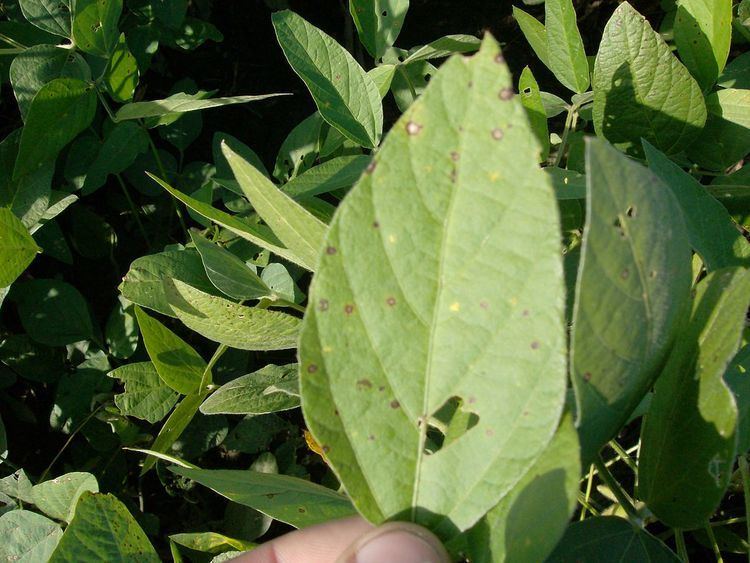Kingdom Fungi | Subclass Dothideomycetidae Rank Species | |
 | ||
Similar Septoria glycines, Cercospora, Peronospora manshurica, Diaporthe phaseolorum var sojae, Diaporthe | ||
First report of strobilurin insensitive isolates of cercospora sojina from arkansas
Cercospora sojina is a fungal plant pathogen which causes frogeye leaf spot of soybeans. Frog eye leaf spot is a major disease on soybeans in the southern U.S. and has recently started to expand into the northern U.S. where soybeans are grown[5]. The disease is also found in other soybean production areas of the world[4].
Contents
- First report of strobilurin insensitive isolates of cercospora sojina from arkansas
- Host And Symptoms
- Environment
- Management
- References
Host And Symptoms
The soybean is the main host of this pathogen. When the pathogen occurs on soybeans, it causes a small leaf lesions. These lesions, mostly found on upper leaf surfaces, are irregularly circular and consist of red-brown to purple colored borders. The inside of the lesion is often a gray to tan color[6]. When the lesions mature they are paper thin and the leaves that are infected have an appearance of being tattered and weathered. The disease can lead to premature defoliation. The Frogeye leaf spot can also form on the pods and stems of highly susceptible cultivars. Oval and circular lesions that form on the pods and stems have dark-colored margins and light gray to reddish-brown color on the inside. If the pod becomes infected, the seeds can also become infected but may be symptomless. If they do show symptoms, gray blotches form on the seed and a cracked seed coat often occurs.[3]
The plant is most susceptible to an infection when the leaves are young and expanding or if the leaves are old and senescing. With this range of susceptibility, the disease can occur several times throughout the plant canopy if the environment is ideal for the pathogen at each leaf layer emergence. This leads to a layered section of disease on one plant. Within a field, the disease often occurs in patches either small or large throughout the field. During Stages R1-R6 in soybeans and after a period of frequent rainfall is the best time to scout for frogeye leaf spot. This disease is typically present mid to late season[3].
Environment
Frogeye leaf spot is often found after warm, humid weather conditions. Frequent rainfalls over an extended period of time can also promote the disease to form. The fungus is known to overwinter in infested seeds and crop residue. If a producer has a field with continuous production of soybeans, there is a higher chance of frogeye leaf spot typically present.[2]
Generally, lesions take more than 1 week to develop after the plant has been infected. This causes the disease to not be visible on the younger leaves of the plant until significantly later. Older leaves are not as susceptible to the disease[3].
Management
Without proper management there can be various consequences of this disease. Yield loss is a huge impact of this pathogen[6]. If a large amount of lesions are present on the leaves of a soybean there is a loss of leaf area index which in turn results in less phtosynthesis. With less photosynthesis, less carbohydrate will be made and the plant will produce less seed.There is also ethylene produced within the leaf spots that stimulates defoliation in the leaves. This will further reduce productivity of the plant [4].
In order to stop yield loss it is important that various methods are used to manage this disease. These include resistance, seed quality, cultural practices and fungicide use. Resistant cultivars exist and can be planted if a producer knows this disease has been a consistent problem. Instead of saving seed, a producer should plant certified disease free seed to reduce the risk of bring the pathogen into the field. Seed Quality is important and can prevent the survival stage of the disease cycle.[3]
Rotation with crops not susceptible to the disease, like corn and small grains, can be a form of cultural control of frogeye leaf spot. This will take away the host in the following season so the survival structure will not have a place to go. Using tillage to disturb the pathogen’s survival structures will also reduce the disease in the future.[3]
Fungicides can be applied to the foliar from the R1-R4 stage of soybeans (late flowering to pod-filling stages). This kind of application can reduce the incidence and severity of the disease. Yield and seed quality can also be improved. In the United States, Frogeye leaf spot has been reported to have resistance to Quinone outside inhibitors (strobilurins). Using multiple active ingredients for a fungicide application can help prevent resistance.[1] Seed treatments are a preventative method that can reduce the threat frogeye leaf spot.
None of these methods have been proven to be better than others but by using multiple of these management tools a grower will help reduce the amount of inoculum available in the field and assist in protecting the plants from infection [6].
